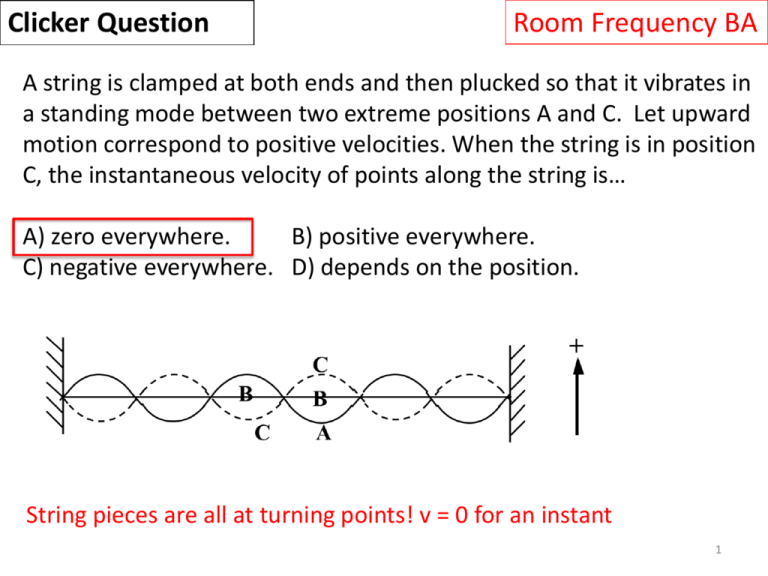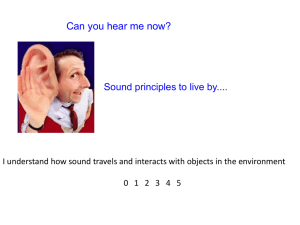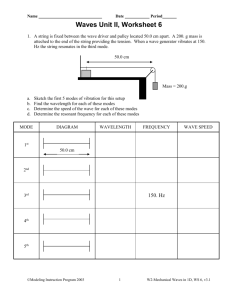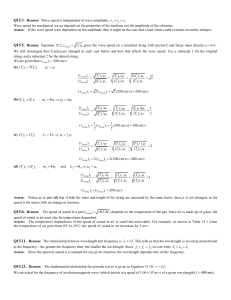PPTX
advertisement

Clicker Question Room Frequency BA A string is clamped at both ends and then plucked so that it vibrates in a standing mode between two extreme positions A and C. Let upward motion correspond to positive velocities. When the string is in position C, the instantaneous velocity of points along the string is… A) zero everywhere. B) positive everywhere. C) negative everywhere. D) depends on the position. No dependence on amplitude String pieces are all at turning points! v = 0 for an instant 1 Announcements • CAPA assignment #14 is due on Today at 10 pm. • CAPA assignment #15 is due on Friday Dec 9th at 10 pm. • Next week: Review in Section, Make-up Labs arranged in other sections. Contact your TA this week to arrange a make-up lab. Last chance to make up labs! 5 labs must be completed in order to pass this course. • Prof. Nagle will be out of town Dec 5,6 so his office hours Monday are cancelled, but he is available later in the week if you wish to meet with him. 2 Final Exam News • Final Exam is Tuesday morning, Dec 13, 10:30am – 1pm • Exam will be held in Coors Event Center, more details next week • Practice Exams and Formula sheet will be posted on Monday Dec 5th • Prof. Nagle will hold a review session on Thursday evening, Dec 8th, 7-9pm, in this room (Duane G1B30). • Exam coverage is cumulative! 3 Sound – Pressure Waves Sound is a type of wave! • In gases and liquids, the waves is longitudinal! • In normal air at room temperature (20°C), the speed of the sound wave is about 340 m/s = 760 mph = 0.2 mi/s • The back and forth motion of air molecules creates regions of low pressure and high pressure which move in the direction of the wave. • When these pressure variations hit your eardrum membrane (or the diaphragm in a microphone), they exert a time varying force on the membrane which has the same frequency or time dependence as the pressure wave. • The ear is VERY sensitive. Pressure variations of 0.00001% can be heard. • The average human can hear frequencies from 20 Hz to 20,000Hz • The average dog can hear frequencies from 20 Hz to 35,000Hz • Frequencies above 20,000 Hz are called ultrasonic 4 Room Frequency BA Clicker Question Hiking in the mountains on a nice summer day, you hear thunder! You look west and see thunderstorms approaching. To estimate how far the storm is from you, you wait to see a flash of lightning, then count the seconds until you hear the thunder. Given that the speed of sound is about 0.2 mi/sec, how many seconds of counting correspond to a mile distance? A) 0.2 B) 1 C) 2 D) 5 E) 10 1/(0.2 mi/sec) gives 5 seconds per mile distance 5 Room Frequency BA Clicker Question Given that the frequency range of human hearing is 20 Hz to 20,000Hz and the speed of sound is 0.2 miles/sec, what is the longest wavelength sound that most humans can hear (in miles)? A) 0.00001 B) 0.01 C) 4 D) 100 E) 4000 λ = v/f and lowest f gives longest λ: 0.2/20 = 0.01 miles = 53 ft 6 Musical Sound Sound which is “musical” usually has only a few main frequencies • Frequency f in music is called pitch • High f corresponds to high pitch • A standard musical note used for getting all the instruments on the same pitch is at 440 Hz (the note A). On a violin, this is the pitch of one of the strings when you do not press on the fingerboard • You change the pitch on a stringed instrument by changing the tension, which chances the speed of the wave. The wavelength is determined by the distance between the points where the string is held fixed. 7 Fundamentals and Overtones When you pluck (or bow) the string it vibrates with many different standing waves. These standing waves have to have nodes at the fixed points at the ends. λ = 2L and f1 = vstring /2L This is the pitch of this note λ = L and f2 = vstring /L = 2f1 λ = 2L/3 and f3 =3 vstring/2L = 3f1 In general overtones are weaker, but not always! 8 Organ Pipes Sounds from pressure waves confined to long pipes also set up standing waves at particular frequencies! • At a closed pipe end, the air molecules have a node in their displacement -> produces an antinode in pressure • At an open pipe end, the wave has an antinode in displacement, and a node in pressure. Pressure Node Pressure Antinode 9 Fundamentals and Overtones in Organ Pipes Even overtones are missing!!! 10 Completely open ended pipes are different! Same overtones as vibrating string 11








